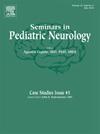Chedíak-Higashi综合症:从头到脚的频谱
IF 2.1
4区 医学
Q2 CLINICAL NEUROLOGY
引用次数: 0
摘要
Chedíak-Higashi综合征(CHS)是一种罕见的常染色体隐性遗传病,由溶酶体运输调节因子(LYST)基因突变引起,导致免疫细胞、黑素细胞和神经元溶酶体功能缺陷。在临床上,CHS以一系列症状为特征,包括免疫缺陷、部分眼皮肤白化、出血倾向、神经发育缺陷和进行性神经退行性症状。CHS的严重程度与LYST突变的类型相关:经典形式与无意义或移码突变有关,在儿童早期表现为严重的免疫功能障碍、复发性感染和高风险的噬血细胞性淋巴组织细胞增多症(HLH),这是一种危及生命的高炎症状态。如不及时治疗,包括造血干细胞移植(HSCT),预后差,生命早期死亡率高。非典型型与错义突变相关,后来表现为较轻的免疫症状,但不可避免地进展为神经损伤,包括认知能力下降和运动功能障碍。诊断CHS是复杂的,由于其罕见,表型变异性,并与其他疾病重叠。综合临床评估、外周血涂片检查白细胞巨粒和LYST突变基因检测的全面方法对于准确诊断至关重要。CHS的管理需要多学科的方法,重点是造血干细胞移植的免疫和血液学稳定和症状和支持护理的神经症状。即使是那些接受稳定HSCT的患者最终也会出现神经系统问题。这篇综述深入探讨了CHS,包括其流行病学、临床表现、分子遗传学、诊断挑战和当前的管理策略,同时强调了综合多学科方法改善患者预后的必要性。本文章由计算机程序翻译,如有差异,请以英文原文为准。
Chedíak-Higashi Syndrome: Hair-to-toe spectrum
Chedíak-Higashi Syndrome (CHS) is a rare autosomal recessive disorder caused by mutations in the Lysosomal Trafficking Regulator (LYST) gene, leading to defective lysosomal function in immune cells, melanocytes, and neurons. Clinically, CHS is characterized by a spectrum of symptoms, including immunodeficiency, partial oculocutaneous albinism, bleeding tendencies, neurodevelopmental deficits and progressive neurodegenerative symptoms.
The severity of CHS correlates with the type of LYST mutation: the classic form, linked to nonsense or frameshift mutations, presents early in childhood with severe immune dysfunction, recurrent infections, and a high risk of hemophagocytic lymphohistiocytosis (HLH), a life-threatening hyperinflammatory state. Without timely treatment, including hematopoietic stem cell transplantation (HSCT), prognosis is poor, with high mortality in early life. Atypical forms, associated with missense mutations, manifest later with milder immunologic symptoms but inevitably progress to neurological impairment, including cognitive decline and motor dysfunction. Diagnosing CHS is complex due to its rarity, phenotypic variability, and overlap with other disorders. A thorough approach, incorporating clinical evaluation, peripheral blood smear for giant granules in leukocytes, and genetic testing for LYST mutations, is crucial for accurate diagnosis.
Management of CHS requires a multidisciplinary approach, focusing on HSCT for immunologic and hematologic stabilization and symptomatic and supportive care for neurological symptoms. Even those patients who undergo stabilizing HSCT eventually develop neurological difficulties. This review provides an in-depth exploration of CHS, covering its epidemiology, clinical presentation, molecular genetics, diagnostic challenges, and current management strategies, while emphasizing the necessity of a comprehensive, multidisciplinary approach to improve patient outcomes.
求助全文
通过发布文献求助,成功后即可免费获取论文全文。
去求助
来源期刊

Seminars in Pediatric Neurology
CLINICAL NEUROLOGY-PEDIATRICS
CiteScore
4.80
自引率
0.00%
发文量
38
审稿时长
84 days
期刊介绍:
Seminars in Pediatric Neurology is a topical journal that focuses on subjects of current importance in the field of pediatric neurology. The journal is devoted to making the status of such topics and the results of new investigations readily available to the practicing physician. Seminars in Pediatric Neurology is of special interest to pediatric neurologists, pediatric neuropathologists, behavioral pediatricians, and neurologists who treat all ages.
 求助内容:
求助内容: 应助结果提醒方式:
应助结果提醒方式:


